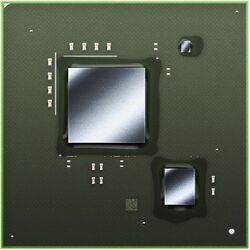Engineering:Espresso (microprocessor)
 An illustration of the Wii U MCM without heat spreader. The smaller chip, lower right, is the "Espresso" CPU made by IBM. The other chips are the "Latte" GPU (large chip, center) from AMD and an EEPROM chip (tiny chip, upper right) from Renesas. | |
| General Info | |
|---|---|
| Launched | 2012 |
| Discontinued | January 31, 2017 |
| Marketed by | Nintendo |
| Designed by | IBM, Nintendo IRD, NTD |
| Common manufacturer(s) |
|
| Performance | |
| Max. CPU clock rate | 1.243 GHz |
| Cache | |
| L2 cache | 1× 2 MB, 2× 512 KB (on-die) |
| Last level cache | 3 |
| Architecture and classification | |
| Application | Embedded (Wii U) |
| Min. feature size | 45 nm |
| Microarchitecture | Not verified by Nintendo |
| Instruction set | PowerPC 1.1 |
| Instructions | 4 |
| Physical specifications | |
| Cores |
|
| GPU(s) | AMD Radeon-based "Latte" |
| History | |
| Predecessor | Broadway |
| Successor | Erista |
Espresso is the codename of the 32-bit central processing unit (CPU) used in Nintendo's Wii U video game console. It was designed by IBM, and was produced using a 45 nm silicon-on-insulator process. The Espresso chip resides together with a GPU from AMD on an MCM manufactured by Renesas. It was revealed at E3 2011 in June 2011 and released in November 2012.
Design
IBM and Nintendo have revealed that the Espresso processor is a PowerPC-based microprocessor with three cores on a single chip to reduce power consumption and increase speed. The CPU and the graphics processor are placed on a single substrate as a multi-chip module (MCM) to reduce complexity, increase the communication speed between the chips, further reduce power consumption and reduce cost and space required. The two chips were assembled to the complete MCM by Renesas in Japan.[1] Espresso itself was manufactured by IBM in its 300 mm plant in East Fishkill, New York, using 45 nm SOI-technology[2] and embedded DRAM (eDRAM) for caches.
While unverified by Nintendo, hackers, teardowns, and unofficial informants have since revealed more information about the Espresso, such as its name,[3] size[4][5] and speed.[6][7] The microarchitecture seems to be quite similar to its predecessors the Broadway and Gekko, i.e. PowerPC 750 based, but enhanced with larger and faster caches and multiprocessor support.
Rumors that the Wii U CPU was derived from IBM's high-end POWER7 server processor proved false, as it would potentially increase the manufacturing and retail cost of the system, and require a larger form factor. Espresso shares some technology with POWER7, such as eDRAM and general instruction set similarities, but those are superficial similarities.[8][9][10][11][12]
Specifications
This section has multiple issues. Please help improve it or discuss these issues on the talk page. (Learn how and when to remove these template messages)
(Learn how and when to remove this template message)No issues specified. Please specify issues, or remove this template. |
- Out-of-order execution PowerPC based cores
- 45 nanometer process technology
- IBM silicon on insulator (SOI) technology
- Backward compatible with the Broadway and Gekko processors
The following specifications have not been officially confirmed by either Nintendo or IBM. They have been obtained by reverse engineering by hacker Hector Martin, alias marcan.[13]
- Broadway-based core architecture[14]
- Three cores at 1.243125 GHz
- Symmetric multiprocessing with MESI/MERSI support[15]
- Each core can output up to 4 instructions per clock using superscalar parallelism.
- 32-bit integer unit
- 64-bit floating-point (or 2× 32-bit SIMD, often found under the denomination "paired singles")
- A total of 3 MB of Level 2 cache in an unusual configuration.[16]
- Core 0: 512 KB, core 1: 2 MB, core 2: 512 KB
- 4 stage pipeline [17]
- 7 stage pipeline - FP[17]
- 6 Execution Units per core (18 EUs total)[17]
- Die size: 4.74 mm × 5.85 mm = 27.73 mm2
References
- ↑ Iwata asks: Wii U: The Console
- ↑ NEW WII U™ ON SOI
- ↑ World Exclusive: Wii U Final Specs
- ↑ Nintendo Wii U Teardown - AnandTech.com
- ↑ Nintendo Wii U Teardown - iFixit.com
- ↑ Wii U has 1.24GHz CPU, 550MHz graphics core
- ↑ Wii U CPU, GPU Details Uncovered
- ↑ IBM puts Watson's brains in Nintendo Wii U
- ↑ IBM teases on Wii U CPU specs
- ↑ Rumored Wii U Specs Raising Eyebrows... for the Wrong Reasons
- ↑ IBM reconfirms the Wii U/Watson connection
- ↑ IBM Confirms WII U Utilizes Power-Based CPU, Not Power 7
- ↑ Joel Hruska (November 29, 2012). "Hackers Discover Wii U's Processor Design and Clock Speed". HotHardware. http://hothardware.com/News/Hackers-Discover-Wii-Us-Clock-Speed-Processor-Design/.
- ↑ @marcan42, Twitter - 2012-12-09
- ↑ @marcan42, Twitter - 2013-11-23
- ↑ @marcan42, Twitter - 2013-01-30
- ↑ Jump up to: 17.0 17.1 17.2 IBM PowerPC 750CL Microprocessor Revision Level DD2.x Datasheet
Further reading
- Wii U graphics power finally revealed
- Nintendo exec denies Wii U processor is 'a little poor'
- First page of developer's user manual



